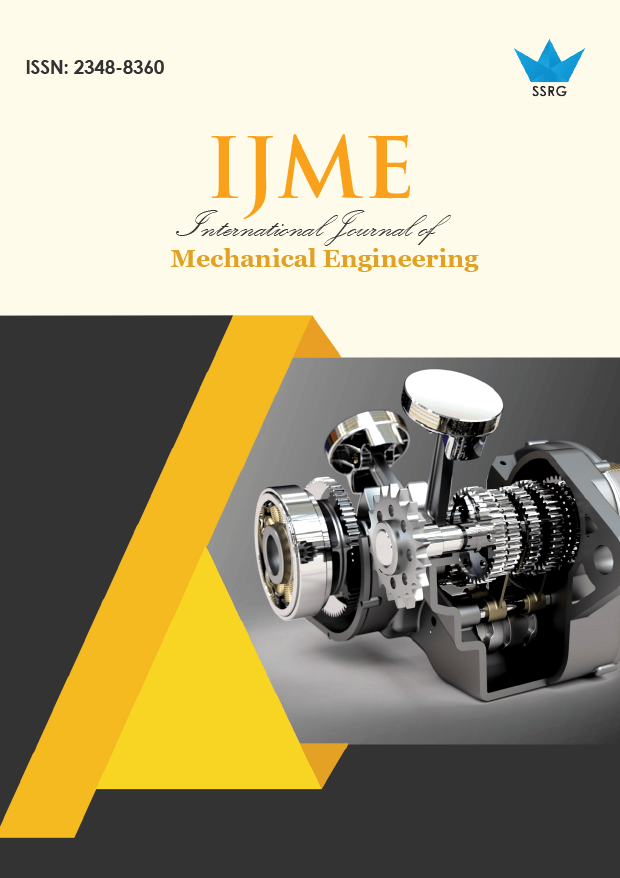Design and Fabrication of Two Wheeler Mudguard using Sisal Natural Fiber

| International Journal of Mechanical Engineering |
| © 2017 by SSRG - IJME Journal |
| Volume 4 Issue 1 |
| Year of Publication : 2017 |
| Authors : Baskaran.S, Justin Dhiraviyam.F, Sathish.K |
How to Cite?
Baskaran.S, Justin Dhiraviyam.F, Sathish.K, "Design and Fabrication of Two Wheeler Mudguard using Sisal Natural Fiber," SSRG International Journal of Mechanical Engineering, vol. 4, no. 1, pp. 1-4, 2017. Crossref, https://doi.org/10.14445/23488360/IJME-V4I1P101
Abstract:
In the current scenario automobile industries focuses on enhancing the strength and reducing the weight of body parts. In two wheelers mudguard is provided to prevent the dirt’s and sand particles in tire from entering and damaging other parts. Presently most of which are made from ABS/Polypropylene plastics. They are of high cost and not completely degradable. In my work an attempt has been made to use strong and abundantly available sisal plant fibers as reinforcement in epoxy resin to make low cost, high strength and less weight substitute for mudguards.
Keywords:
ABS, Sisal, Epoxy
References:
[1] L.Boopathi, P.S.Sampath, “conceptual design of two wheeler bumper made from alkali treated borassus fruit fiber reinforced epoxy composites”, (2012), European journal of scientific research, vol.79, pp.353-361.
[2] K.L. Fung, X.S. Xing, “ An investigation on the processing of sisal reinforced polypropylene composites”, (2003), composites science and technology, vol.63,pp.1255-1258.
[3] Georgios korosis, Arlindo silva, “A review of adequate materials for automotive applications”,(2012), composites,vol-nil, pp.-nil.
[4] Gikuru mwithiga, janet mutheu mwania, “ Influence of sisal fiber content on tensile and bending strength of sisal/epoxy composites”, (2006),journal of engineering and applied sciences,vol.4,pp.508-512.
[5] Krishnan jayaraman, “Manufacturing sisal-polypropylene composites with minimum fiber degradation”,(2003), composites science and technology, vol.63,pp.367-374.
[6] Ling sun, xiaoming liu, “control analysis and apparent quality of automobile large plastic parts”,(2011), procedia engineering,vol.16.pp.438-443.
[7] H.S.Park, X.P.Dang, “Development of short fiber reinforced plastic front side panels for weight reduced automobiles”,(2010), journal of automotive technology, vol-nil,pp.nil.
[8] Baskaran, S., & Venkadesh, S. Exergy Analysis In Ic Engine Using Diesel Blends As A Fuel. International Journal of Applied Engineering Research, 10(7), 2015.
[9] Saravanakumar, N., Prabu, L., Karthik, M., & Rajamanickam, A. (2014). Experimental analysis on cutting fluid dispersed with silver nano particles. Journal of Mechanical Science and Technology, 28(2), 645-651.
[10] Sathiseelan, N., and S. Baskaran. "Optimization of welding parameters using plasma arc welding for SS316 material." Optimization 6.1 (2016).
[11] Gokilakrishnan, G., Divya, S., Rajesh, R., & Selvakumar, V. (2014). Operating Torque In Ball Valves-A Review. International Journal for Technological Research in Engineering, 2(4), 311-315.
[12] V.Naveenprabhu, K.Saravanakumar, T.Suresh and M.Suresh, “Experimental investigation on tube-in-tube heat exchanger using nanofluids”,(2016), Advances in Natural and applied sciences,Vol.10.pp.272-278.
[13] A. Elsabbagh, L. Steuernagel, J. Ring, “Natural Fibre/PA6 composites with flame retardance properties: Extrusion and characterisation”,(2017),Elseiver,Vol 108,pp.325- 333.
[14] S. Witayakran, W. Smitthipong, R. Wangpradid, R. Chollakup, P.L. Clouston “Natural Fiber Composites: Review of Recent Automotive Trends”, (2016),Journal of material science and technology, Vol 10,pp 210-215.

 10.14445/23488360/IJME-V4I1P101
10.14445/23488360/IJME-V4I1P101